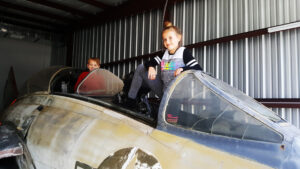Randy Beavers has just finished the restoration of a TF-9J Cougar fighter jet in his garage.
Beavers is not a multi-millionaire adding another piece to his collection or restoring the aircraft for a museum or private collector. But, instead, he is an ordinary Madison dad who is restoring the aircraft to display at his kids’ high school.
The jet is at James Clemens High School where it was formally dedicated last Thursday.

The Grumman TF-9J was an advanced jet trainer version of the fighter aircraft that was used extensively by the Navy and Marine Corps in the 1950s and 1960s.
During the Korean War, the United States was still largely using propeller planes but the Navy and Marine Corps flew the Grumman F-9 Panthers. While U.S. fighters fared well in those dogfights, the Soviet Union’s MiG-15 had some distinct advantages in aerial combat due to its swept wing design. The Panther, and other early U.S. jets, had a straight wing like the World War II-era propeller planes.
“The Cougar is a direct development from the Panther,” Beavers said. “It has a different wing and a different engine than the Panther; but most of the rest of the parts are the same.”
Grumman built the first Cougar prototype in 1951 but the Navy’s newest warbird did not arrive off the assembly line in number in time to be deployed to Korea. It did however make up the backbone of the Navy and Marine Corps’ fighter force between Korea and the Vietnam War.

The two seat TF-9J was the advanced jet trainer version of the Cougar. It was such a good combat trainer that it remained the Navy and Marine Corps’ primary advanced jet combat trainer even after newer models of aircraft such as the A4 Skyhawk and F4 Phantom II replaced the Cougars. Most of the Navy and Marine Corps fighter pilots in the Vietnam War trained in the Cougar. The final Cougars were retired from duty in the 1970s. Beavers said that the Reserves still had some Cougars into the 1980s.
“We were still learning about jets then, so the Cougar is underpowered,” Beavers said. “But pilots loved it because it was tough.”
Beavers said his jet was deployed on aircraft carriers and was donated by the Navy to a high school near Meridian, Miss., in 1974. It was taken down in the 1980s and moved to a private museum in Mississippi. That museum eventually fell into disrepair and the Veterans Museum in Huntsville agreed to take it.
To bring it to Huntsville, though, the high tail and the wings would both have to be cut off for it to be transported.
“Those guys were real careful,” Beavers said. “They went back and forth to Mississippi for three years” to remove the wings and the tail without irreparably damaging the aircraft. “They did a really good job.”
“It sat at the Veterans Museum for three or four years. They did not have the money to restore it.”
Beavers had been wanting to restore a classic warbird as “a bucket list project.”
The guys at the museum said that they had this aircraft.
Yellowhammer News asked how he had acquired the skills to even attempt to restore the aircraft.
“That is my background,” Beavers said. “I was a Blackhawk crew chief and an aviation mechanic.
“I have just loved aviation from the get-go.”
James Clemens High School was being built when this project started. When the school adopted the Jets as the mascot, placing the plane on display there made sense.
“My daughter is a sophomore there,” Beavers said. “My son is in the seventh grade and will go there.
“The aircraft is on permanent loan from the Naval Museum. They are the official owners.”
They supervised the project and insisted on the original paint scheme.
Beavers said that he was fortunate the jet was intact. Parts could have been fabricated with 3D printing; but that was not necessary.
“Fortunately, I did not need any parts,” Beavers said. “I spent over 2,800 hours on it,”
The money for the restoration was raised by “Col Courtney Taylor and I. It was all private donations and corporate donations.”
The Junior ROTC at James Clemons High School will be responsible for maintaining the aircraft.
“They are the keepers of the jet,” Beavers said
Now, that this project is complete, what’s next?
“My wife said I could not bring any more jets home,” Beavers said. “I think I will get my pilot’s license.”
To connect with the author of this story or to comment, email [email protected]













